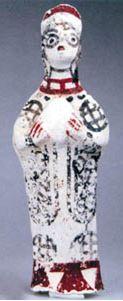Apotropaic Guardians, Ancient Symbols, Divine Icons or Children’s Toys?
The many interpretations of Israelite plaster figurines
Source - http://www.biblicalarchaeology.org/daily/biblical-artifacts/artifacts-and-the-bible/apotropaic-guardians-ancient-symbols-divine-icons-or-children%E2%80%99s-toys/

Plaster figurines have been interpreted in countless ways, as anything from apotropaic spirits to toys. While the meanings of these ancient symbols are evasive, context and typology are an archaeologist’s best tools.
Clay, stone and plaster figurines have been found across the ancient world, but their significance repeatedly mystifies archaeologists. What are these ancient symbols? Could they be apotropaic guardians, children’s toys, goddesses?
Plaster figurines, such as this example from the Hecht Museum at the University of Haifa (pictured), can crumble over time, and are comparatively rare in the archaeological record. This figurine’s original context is uncertain, so it must be analyzed through comparison to other plaster figurines. Typological comparisons suggest that the statuette is Roman or Byzantine, and scholars have called some contemporary plaster figurines apotropaic. Apotropaic (meaning protective from evil spirits) is a very common designation for these ancient symbols.
Interpretations of these ancient symbols run the gamut, from games to gods. In her study of this figurine, Renate Rosenthal-Heginbottom, who has taught at the Hebrew University and digs at Tel Dor, quotes another Israeli scholar, Raz Kletter, to reject interpretations of plaster figurines as “toys, mortal figures, mother goddess, nurturing goddess, fertility goddess, [etc.]”* She then suggests the figurine had an apotropaic function.
There are many questions archaeologists can ask to evaluate the function of these ancient symbols. How and where were they made? Who worked with paints and plasters in the local communities where they were made? Are other ancient symbols or apotropaic objects created out of these materials? Are similar plaster figurines found in churches, shrines, graves, homes or workshops? Did neighboring cultures use such objects and, if so, how?
This particular figurine is painted in red and black and depicts a woman wearing a floor-length tunic with a red neckband. The roundels on her shoulders are repeated near the bottom of her skirt. On the bottom edge of the tunic is a band with triangles, colored red like the neckband. The woman has large eyes with eyebrows and wears a red cap. Between her breasts she holds a large egg-shaped object.
But who is she, and what is she holding? Without a clear context, chronology or established typology, it is impossible to say for certain. Bible History Daily readers are encouraged to offer their interpretations in our comments section below.
Notes
Renate Rosenthal-Heginbottom, “Statuettes in Clay and Plaster in the Hecht Museum Collection,”Michmanim 23 (2011), p. 21.